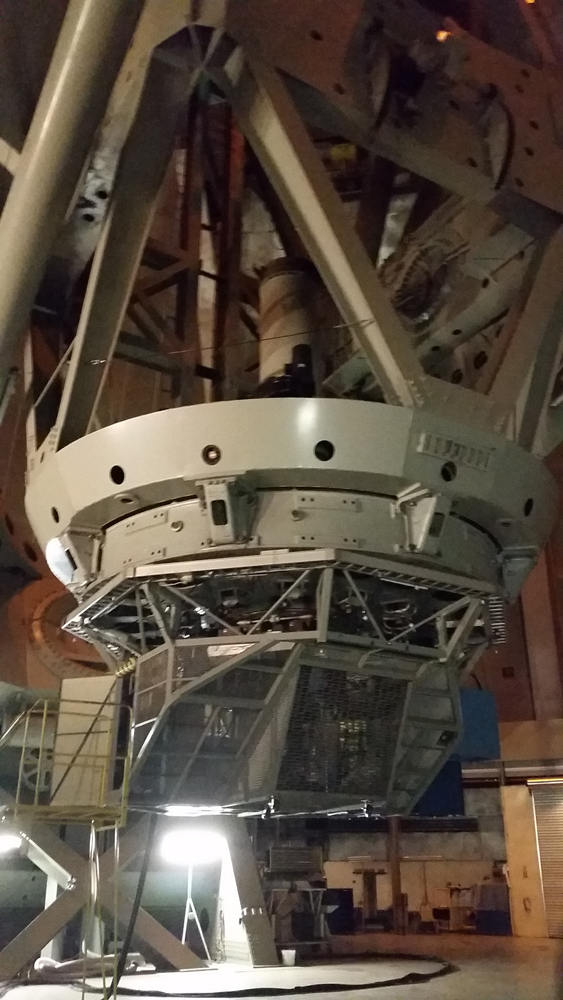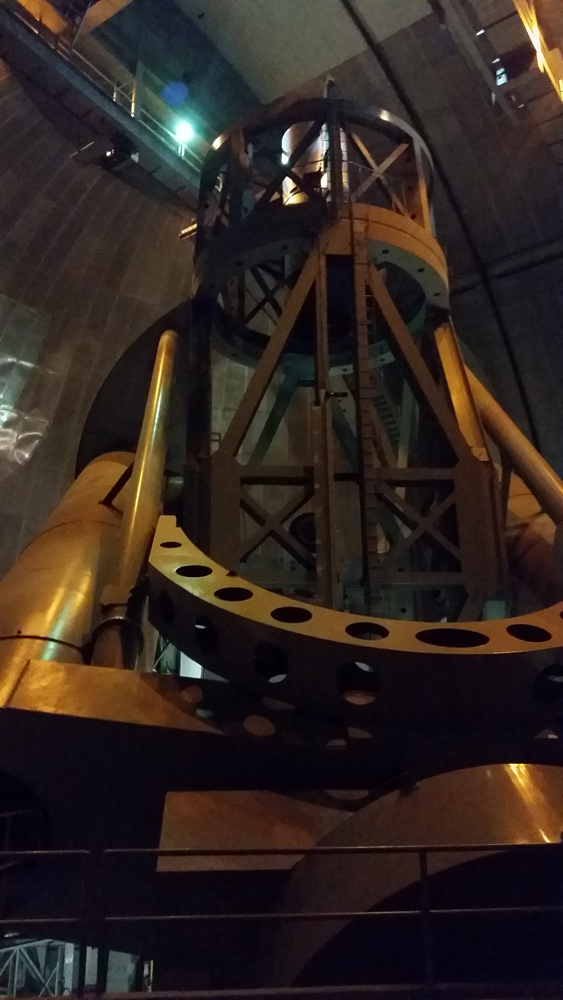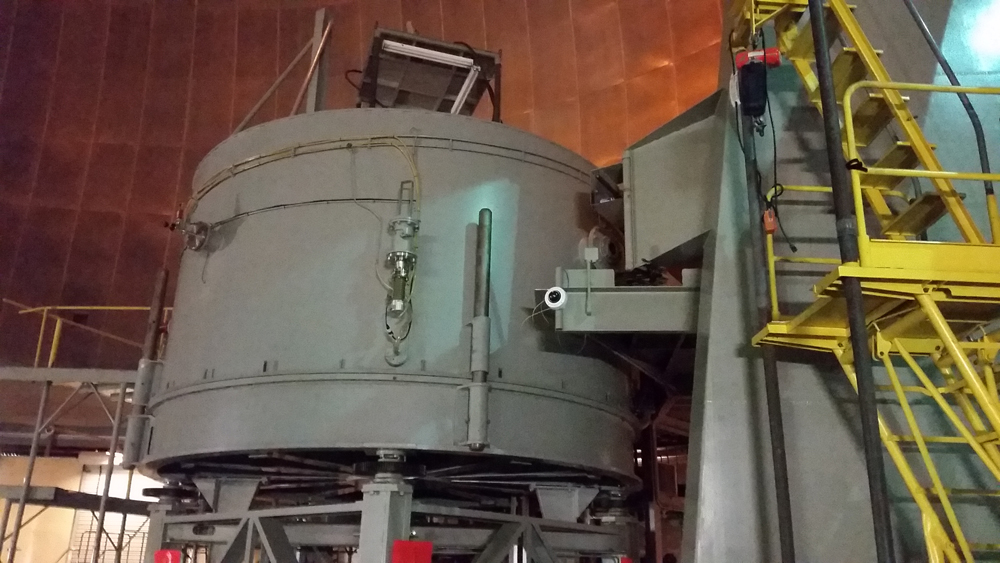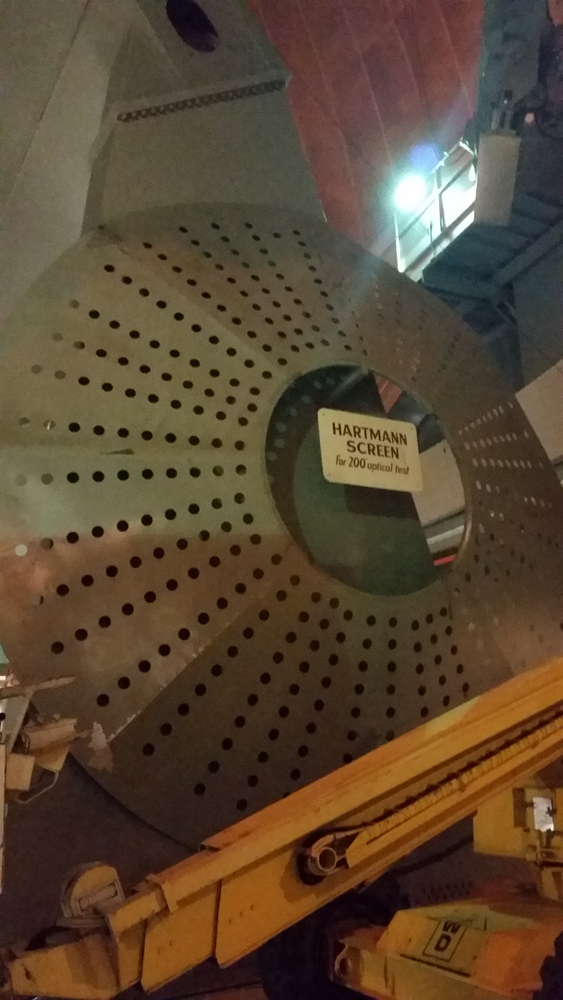Touring the Palomar Observatory, Home of the Hale Telescope

The iconic Palomar Observatory in Southern California has welcomed astronomers to its mountaintop perch for almost 80 years.
Its massive, 200-inch (5.08 meters) Hale telescope doubled the known size of the universe, characterized its expansion and probed the edge of the solar system, turning up a previously unknown cache of dwarf planets that brought about Pluto's demotion. The very first instrument used at the observatory created a broad map of the sky that the Hubble Space Telescope uses today.
On a bright June day, I traveled with several astronomers and other members of the press to the observatory, which is managed by the California Institute of Technology (Caltech). Andrew Boden, the deputy director of the Caltech Optical Observatories, and Steven Flanders, Palomar outreach and event coordinator, were both on hand to take us behind the scenes of the historic facility. [Tour the Palomar Observatory (Photos)]

The path to Palomar
Our journey began with an uneventful drive to the outskirts of San Diego County. Palomar is located about a 2-hour drive northeast from San Diego, where we had just wrapped up the American Astronomical Society's summer meeting, or about 2 hours southeast of Los Angeles. The countryside was fairly flat and desert-like until we reached the mountains and found ourselves suddenly climbing upward.
Palomar Observatory sits at the end of a long and winding mountain road. We spent nearly half an hour snaking through scraggly brush as I peered out the window hoping to catch a glimpse of the observatory before the group arrived. We passed caution signs related to rockslides, along with one particularly strict warning: "It is unlawful to throw snowballs at vehicles or their occupants." My ears began popping at around 4,000 feet (about 1,200 meters) in altitude. When we were nearly there, other passengers excitedly announced that they could see the dome, but it remained unglimpsed from the backseat where I resided.
As we pulled up, the road separated. The left side offered visitors parking, for people who wish to walk the grounds, head to the visitors center or catch a glimpse of the instrument from the visitors gallery, a glass-encased hallway that allows the public to glimpse the inside of the observatory without disrupting ongoing research. As directed, we pulled instead to the right, set aside for authorized parking only. The observatory is open to the public daily except for Dec. 24 and 25 and during weather emergencies. An elevation sign notified us that we sat at 5,550 feet (about 1,700 m).
The magnificent white dome shone brightly as we pulled up and stretched our legs. Flanders waited outside the entrance and welcomed us all. The human-sized entrance was surrounded by the outline of a large loading door. A sign informed us that while the historic dome was not handicap-accessible, the visitors center offered the opportunity for people of all abilities to peer inside the working observatory.
Get the Space.com Newsletter
Breaking space news, the latest updates on rocket launches, skywatching events and more!
After I'd been squinting in the bright sunlight, the dim interior gave welcome relief. The basement of the observatory had the orange tint familiar to anyone who has visited an observatory: The orange lights allow a person to see his or her surroundings, but they are dim enough so as not to break your night vision. Orange lights glowed even where we stood in the basement, away from the telescope. Framed drawings of the observatory and its instruments hung on the walls as I wandered the halls in search of a restroom.
My self-tour complete, I rejoined the group after Boden had come down to welcome us as we gathered by the observatory's massive front door. The thick beams and bare walls reminded me of a factory or a metalwork shop, with the musty scent reminiscent of my grandmother's basement.
The massive beams above us supported the 200-inch Hale telescope, which weighs in at 530 tons, Flanders says. The steel supports sink 22 feet (6.7 m) into the bedrock and stand separate from the building itself to minimize the vibrations the instrument experiences.
Astronomer George Ellery Hale built the world's largest telescope four times over, each new instrument trumping the last. Palomar was his crowning achievement. Its reign as the world's largest telescope lasted for over 40 years, until the Keck telescope on Mauna Kea in Hawaii took the title in 1992.
The Hale telescope quickly began to scan the heavens after its 1948 dedication, but the work of constructing the instrument began more than a decade earlier. In addition to the halt created by World War II, creating what was then the world's largest telescope brought its own special challenges.
The first steps toward building the instrument were taken in 1935, when the dome was built, while the massive mirror began construction in 1936. The telescope construction was rapidly completed, and extra gears were stored in the observatory, now hanging on the basement wall, where they could be used for future repairs.
"Of course, they never needed them," Flanders says. The telescope still relies on the gears installed with it 67 years ago.
To the right side of the door sits a large metal cylinder, a vacuum chamber to clean the smaller mirrors. Standing on its side, the mirror is slid into the chamber, which closes and seals off the air. Aluminum plasma circulates inside the chamber, coating the mirror to keep it reflective.
"Of course, we can't keep it outside," Flanders says, "because nature abhors a vacuum."
He pauses to let us groan at the bad joke.
To the left of the door, a set of metal stairs beckoned. We file up the steps toward the second floor, where the historic Hale telescope awaits us.

Hale telescope
The Hale telescope sits silently, a giant workhorse pointed toward the heavens. The dome above it is closed, but the instrument seems anxious to observe. A cool metallic gray, the giant points toward the sky above, while a slew of electronics replacing the original eyepiece hang off the instrument's underside to make it more efficient.
Engineers completed the body of the telescope rather quickly, though they made a number of innovations with the design, Flanders tells us. Knowing that the telescope's weight would make it difficult to move, they designed a system of four oil bearings, with oil pads riding the outer edges. When astronomers begin observing, a sequence of oil pumps on the mezzanine level pump 750 lbs. per square inch of oil onto the oil pads, raising the telescope 8/1,000 of an inch, Flanders says.
"The telescope floats on that film of oil virtually frictionlessly for the night's observing," Flanders says.
The instrument also has an odd horseshoe-shape truss that helps as the telescope moves across the sky. This helps to distribute the instrument's weight. The sides of the truss were precisely determined so that they deform along with the telescope as its weight shifts, with both ends deforming exactly the same way.
While the instrument was swiftly built, the mirror proved to be more challenging. To minimize the amount of flexing caused by changing temperatures, the mirror was originally planned to be built from quartz. However, the amount of quartz required proved to be too difficult to obtain. Hale then approached Corning Glass Works in New York to produce the material out of Pyrex.
On March 25, 1934, 20 tons of molten glass poured into the mold, causing a new problem. Firebrick, a masonry brick, had been attached to the bottom of the oven to create empty voids. These holes would create spaces for air to flow through the Pyrex, allowing the temperature of the mirror to balance out more quickly than it would as a solid disk. The voids also reduced the mirror's weight from 40 tons to 20 tons. But the molten glass was so hot that it melted the bolts holding the firebricks in place. The melted metal mixed in with the glass, ruining the first attempt.
A second disk was poured in December of that year, gradually cooling over a period of 10 months. Then, in 1936, the mirror blank began its two-week trip by train from New York to California. Thousands of people across the country lined the tracks to watch the enormous mirror pass by.
Although the mirror had been poured, it still wasn't quite ready for the telescope. It needed to be ground into the proper shape, a process that took place at Caltech. The grinding further reduced the mirror from 20 tons down to 14.5 tons. Before the mirror could be completed, World War II began, and challenges kept it in the shop for nearly a dozen years. While they waited for the glass mirror, engineers constructed a concrete "mirror" to stand in for the glass one on the instrument, in terms of both size and weight, to ensure the enormous telescope base functioned properly as it maneuvered what was at the time the world's largest mirror. The concrete disk lies discarded outside, near the parking lot.
But when the mirror finally arrived at Palomar, it still wasn't perfect.

"What they ended up doing is going down to a sporting store down here at Lake Henshaw and buying four fish scales to add just a little more pull on the back of the mirror," Flanders says.
That's fish scales as in, the scales used to weigh the fish, not the scales on the fish itself.
Even with the help of the scales, however, the edges of the mirror didn't sag as expected. To help fix that problem, astronomers used a giant silver screen that looks a lot like a collapsible colander, with 400 precisely placed holes (plus one to indicate north).
Sitting on the observatory floor today, the strange object is labeled as the Hartmann screen. Named after the German astronomer who invented it, it was something of a rough draft of the mirror, because it outlined the precise shape the mirror should take (including the expected sag) when installed in the telescope. Astronomers placed the mirror, still lacking in its reflective surface, on the telescope, with the Hartmann screen at the top, then photographed a bright star. Initially, the holes on the screen didn't line up with the massive mirror below. Over the course of 18 months, the observatory team would take a picture, work on the mirror position a little bit and then wait for it to cool back down to start the whole process again.
"Every time they touched the mirror, they had to wait for that section of the mirror to cool off," Flanders says. According to estimates, over those several months the engineers touched the mirror for a total of only about 19 hours. The rest of the time, they were waiting to let it cool off from the friction.
The second floor of the observatory also contains a massive cylindrical container, larger than the vacuum chamber downstairs but with the same purpose. About every two years, a series of gears lifts the enormous mirror and moves it into the upstairs vacuum chamber. The mirror is cleaned with an acid bath to remove the previous aluminum layer, and then a new layer is added.
While we listen to our tour, people move in and out of the visitors gallery. The observatory itself isn't open to the public. Instead, visitors file in through a booth where they can peer at the enormous telescope through a pane of glass. I feel fortunate to get a much more in-depth look.
We climb another series of metal stairs to the mezzanine level, where we stand above the electronics to observe the instrument. Here, we can more clearly see how the telescope would move (though it lies quiet while we are there).
To move the telescope across the entire sky takes a couple of minutes. In tracking mode, the 530-ton telescope was originally moved by a 1/12-horsepower motor, Flanders says, a motor as powerful as one found on a Singer sewing machine. Eventually, the motor was replaced, but not because it wore out; the scientists wanted a motor that could provide finer control than the original allowed.
On the mezzanine, we can also observe the long metal tubes along the side of the instrument. Those once housed the adaptive optics, which involve using a laser to create a "fake" star that astronomers rely on to correct for distortions in the atmosphere. The laser was decommissioned "some time ago," Flanders tells us. Increased traffic from the nearby airport meant probing the night sky with the laser was dangerous for pilots.
Our last stop is the brightly lit office, where old and new computer panels sit. These allow outside astronomers to use the observatory. The Hale telescope can be utilized by astronomers around the world; while they can observe from home, they can't control the instrument. Instead, they communicate with astronomers at Palomar, who then move the telescope.
"We don't support remote operation, but we support remote observation," Boden says. "We don't let people drive."

Awe inspiring
Once again, we enter the bright sunlight, squinting as our eyes adjust from the dim lights of the observatory. We file down the short walk to the visitors center. Here, a screen provides a glimpse of the Hale telescope for folks who can't access the building itself. A time-lapse film of the vacuum process is also provided. A model of the telescope and the Pyrex mirror sits on display, along with newspaper clippings about the construction of the facility and a map of the mirror's cross-country journey. (Not surprisingly, it avoided the more mountainous regions of the West, taking a more southern route.)
Also on display is Palomar's first major instrument, the 18-inch (46 centimeters) Schmidt telescope. The only instrument at the observatory for over a decade, the Schmidt telescope began its career in 1936. With the arrival of the Hale telescope, the Schmidt began to acquire targets for the larger instrument, as well as search for minor bodies in the solar system. Over its lifetime, it discovered a variety of comets and asteroids.
The visitors center is closed when we arrive, and we are greeted by several scientists working with Caltech. They discuss their research with us and describe how they use the telescopes at Palomar to probe the depths of space today.
Finally, it's time to head back home. We take a few last photographs and ride down the mountain in silent contemplation.
Palomar Observatory is a place of historical significance for astronomers. According to the observatory's website, astronomers like Edwin Hubble and Allan Sandage used Palomar's instruments to increase the world's knowledge of the universe. Fritz Zwicky discovered 120 supernovas with Palomar's Schmidt telescope, holding the record until 2009 for the most found by a single person. Using the Hale telescope, Sandage determined that the universe was essentially the same in all directions, a basic premise for modern cosmology (and one that wasrecently confirmed with new data). Comet Shoemaker-Levy 9, which broke apart as it collided with Jupiter in 1994, was first spotted at Palomar, as was the dwarf planet Eris, a discovery that set the stage for the demotion of Pluto to a dwarf planet.
When we arrived, Boden told us that he had been somewhat amazed when first appointed director of Caltech's optical observatories.
"I grew up in elementary school reading about this place," he said. "To be in a position of stewardship is truly humbling and awe-inspiring, and really, really cool."
After visiting this historic site, I can't help but feel the same way.
Follow Nola Taylor Redd on Twitter @NolaTRedd or Google+. Follow us at @Spacedotcom, Facebook or Google+. Originally published on Space.com.
Join our Space Forums to keep talking space on the latest missions, night sky and more! And if you have a news tip, correction or comment, let us know at: community@space.com.

Nola Taylor Tillman is a contributing writer for Space.com. She loves all things space and astronomy-related, and enjoys the opportunity to learn more. She has a Bachelor’s degree in English and Astrophysics from Agnes Scott college and served as an intern at Sky & Telescope magazine. In her free time, she homeschools her four children. Follow her on Twitter at @NolaTRedd









